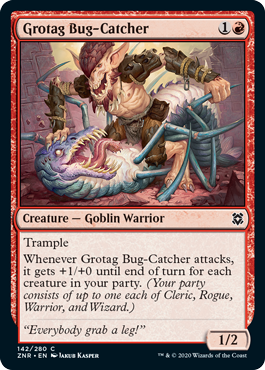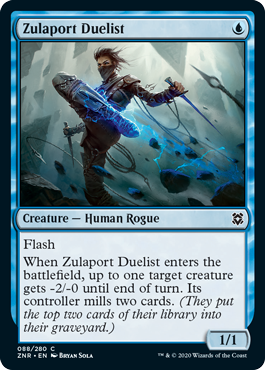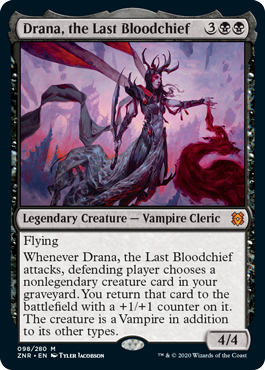Zendikar Rising to the Challenge, Part 1
Welcome to the first week of Zendikar Rising previews. Today, I'll begin by telling you the story of the set's design, introducing you to the Vision Design team, and previewing a bunch of cards. You all know the drill, so let's get to it.
Click here to meet the Vision Design team
Andrew Veen

Andrew had started in R&D as a designer for a different set of trading card games (Kaijudo and Duel Masters) but dabbled in Magic design until we made him a full-time hire. He had previously been on the design teams for Shadows over Innistrad and was my strong second on Ikoria: Lair of Behemoths. The thing I appreciate most about Andrew is that his designs do a good job of taking into account so many of the issues that are going to mean something to people downstream of vision design. Andrew is one of those designers that just has a good sense of Magic from beginning until end. For example, not a lot of vision designers spent time on the Play Design team. I was glad to have him on the team.
Erik Lauer

Erik was the set design lead for Zendikar Rising. The set design lead will often be on the vision design team to get a sense of how the vision for the set is being created. Erik is usually too busy to do this, though, so this was the first time that I'd ever had Erik on one of my design teams. I've handed off designs to him numerous times, but we'd seldom worked together before on the same team, especially on vision design. The thing I appreciate about Erik is his ability to dig down deep and understand whether something is going to actually work when exposed to the rigors of gameplay. Players will often not use cards or a mechanic the way you intend, and Erik is great at making you see that as you're crafting it.
Tom Ross

One of the things the Play Design team likes to do is rotate in pro players for some duration of time to help bring their perspective to the play design process. During Tom's time at Wizards, I was glad to have him be the play design representative for Zendikar Rising. This position helps us ensure that all of our costing is close enough to not cause playtesting issues and that we're making things which can be balanced later during play design. The thing I appreciate most about Tom is the dedication he had to running all the possible scenarios to whatever problem he was examining. His thoroughness gave me a lot of confidence, and he was a good addition to the team.
George Fan

George is the designer of Plants vs. Zombies. I met him many years back when I gave him a tour of the office. During the Great Designer Search 3, George let me know he was trying out because he thought it would be fun to work in Magic R&D for six months. I let him know that if he was interested in doing it, he didn't need to go through a whole GDS. George was originally brought on for six months but ended up staying for a year. I loved working with George, and you will hear numerous stories over the coming months as we get to projects George and I worked on together. This was his first design team with me. Erik had to swap off the team due to another project, so George joined the team in his place. The thing I appreciate most about George is that he brings such a fun energy to any team he's working on. He's been a fan of Magic forever, and you could just tell how much he enjoyed designing cards. Zendikar Rising definitely benefited from having him on the team.
Mark Heggen

Mark is one of our product architects. Their job is to oversee a product from beginning to end and make sure that all relevant parties in the whole company are aware of different decisions being made by various teams. They're usually the one person who is on the product its entire life (and for most products, that's over two years), and it's important they understand what each team that touches the product is doing. Because of that, Mark asked to join the team so that he could get a better sense of the vision design process. The thing I appreciated most about Mark is that his perspective allowed him to ask questions that I don't usually get to answer. He also is a great partner to work with, so I was glad to finally get him on one of my design teams.
Zendikar holds a special place in my heart. When I first pitched it (as a bottom-up mechanical land-focused world), it didn't exactly have a lot of fans. It took significant effort to even get it on the schedule. Once I did, I was told I had three months to prove my concept or we were going to switch to a different design. Along the way, Doug Beyer came up with the amazing adventure-world theme to complement the land-focused design, and the set slowly gained fans internally. It was a big day for me when the set released to such fan excitement.
Zendikar block had been designed to have a large fall set, a small winter set, and a large spring set (note these are Northern Hemisphere seasons). I'd experimented two years before with making Shadowmoor a large set (as part of making a four-set block work), which demonstrated that we could do large sets at times other than the start of the Magic year in fall. The reason I was given the go-ahead for Zendikar in this block was that the plans were to have the large spring set move to a completely different world with totally different mechanics, and due to some skepticism about a land-focused world, why not put it in a block where it only had to fill up two sets?
The Creative team was very happy with the world they built and, at the time, wasn't staffed up to create a second world in one year, so they pitched a story which would allow the world to have an event so big that it could necessitate a complete changeover of the mechanics. That story element would be the introduction of the Eldrazi. They were teased in the first two sets, but wouldn't break free until, well, Rise of the Eldrazi. The design for that set was led by Brian Tinsman, and it went all-in on what Brian called "battle cruiser Magic," where players smashed into one another with giant creatures. The block ended on a giant cliffhanger—the Eldrazi were free, what would happen to the world of Zendikar?
When we came back in Battle for Zendikar, I felt compelled to pick up where the story left off. Let's see a war between the Eldrazi and the denizens of Zendikar (as well as some Planeswalkers, but that's a story for a different time). With 20/20 hindsight, I think that was a mistake for numerous reasons. One, I believe the Eldrazi work best in smaller numbers. They should be a flavoring of a set, not the main course. Two, it pulled away from what made Zendikar so charming, the adventure world. There was no way to give the war the support it needed, card-wise, without having to sacrifice other elements of Zendikar. The end result of all of this was I made a design that I wasn't particularly happy with. (I should stress that Erik did a great job in development whipping the set into shape.)
This all brings us to the design of Zendikar Rising. Zendikar was a world I cared very much about, and I felt that my last design there had dropped the ball. I really wanted to make sure I redeemed not just myself, but the world of Zendikar. It was important to me to recapture what made Zendikar so lovable in the first place. My vision from day one—a return to what made the original Zendikar set so special.
Time to Party
When returning to a world, you spend a lot of time figuring out what returns and what doesn't. I'll be getting to that next week. You also want to find something new that you can bring to the world mechanically. The challenge here—how do I recapture the spirit of original Zendikar while delivering something new that the players had never seen on Zendikar? The answer was to dive deep into the spirit of adventure world.
I'm a big fan of resonance, so I asked my design team about what comes to mind when they think of an adventure world. We made a long list. Most of the things we'd done back in Zendikar (probably because we did the same exercise back then). Was there anything that we could attempt, but from a different angle?
One idea we had was the concept of an adventure party. All of us had played Dungeons & Dragons where we had a motley crew of different characters roaming through an adventure. Original Zendikar had hit this trope with Allies, but maybe there was a way to execute the idea differently. Allies played up the idea of working together. You were rewarded for having a lot of Allies in your deck. What if we focused on the idea that a party is usually made up of a wide variety of different kinds of characters?
For example, in D&D, it's important to have breadth to your adventure party so you have someone with expertise at whatever problem comes your way. Get into a fight or need something solved with strength? A fighter can help. Need help picking a lock or dismantling a trap? You want a rogue. Might you need a magical spell? Well, both wizards and clerics can be useful in different ways. The idea we latched onto was finding a way to care about building a party of a variety of different kinds of creatures.
We started by figuring out how best to represent the different members of your adventure party. How would we do that? Class creature types were the low-hanging fruit. Wizards could obviously be Wizards, clerics could be Clerics, and rogues could be Rogues. Fighter was the one D&D class that didn't have a direct creature type link. However, there were a number of options that were basically fighters: Barbarian, Berserker, Knight, Ninja, Rebel, Samurai, Soldier, and Warrior. Barbarian, Berserker, Knight, Ninja, Rebel, and Samurai were all too specific, leaving Soldier and Warrior. Soldier implied the fighter was connected to some larger entity, which didn't fit a lot of fighters, so we went with Warrior.
Next was figuring out a way to care about having a mix of the various different creatures. Again, we went with the lowest hanging fruit. If you had a Cleric, Rogue, Warrior, and Wizard, you got a bonus. That was just too high of a bar. You needed not only four creatures, but the correct four. What if we rewarded you for having some and more for the more you had? In other words, what if we made the effect scale? Using the batching technology that we created for historic (from Dominaria), we invented a new term called "party." A party meant that up to one of each of our four different classes—Cleric, Rogue, Warrior, and Wizard. Cards could refer to party as a means to either set a number or exist as a threshold.
We playtested party and liked it a lot. It had a bunch of things going for it. One, it was super flavorful. It really captured the adventure world resonance we were looking for. Two, it had a nice quality that grew as the game progressed. Three, it gave players a little quest to try and achieve. It was hard enough (but not too hard) that accomplishing it would feel really good. Four, tribal is a theme we hit a lot (it's pretty popular), but this was us approaching it in a different way than normal. Most tribal themes are about getting a lot of the same thing together. It's always exciting when we can approach a popular theme from a different vantage point. Magic tends to thrive on "familiar but different."
It did have some issues, though. First, there's a limit to scalable effects. Working on set after set, you learn to categorize different mechanic tools, and scalable effects is a tool we go to often. It's large enough to make a mechanic out of, but it's small enough that it would be tight. Second, it pushes in a way that's trickier to solve than normal tribal. For example, Allies just say "put a lot of Allies in your deck." Party wants you to put in some amount of each, which is a more complex ask of the player. Note that we designed the mechanic to work just fine even if you never reach a full party. If you don't happen to have a Warrior, for example, you can play the other three and still get plenty use out of party.
As a quick aside, to avoid a question you'll ask in the next paragraph, we did discuss having a fifth class (Magic does love having things in five), Druid. It turns out that the math works to make four creature types viable, but not five creature types. Part of capturing the adventure world feel of Zendikar was also capturing all the non-humanoid creatures of the world, and a fifth party member would prevent us from doing that, as it would have to eat up that space. In addition, it didn't line up with the scalable effects as cleanly as four classes did.
This brings us to the problem of fitting four classes into five colors. We discussed just putting each creature type equally in each color, but it didn't allow us to differentiate the colors and made it harder for us to build around the mechanic. We realized that each of the four classes lined up neatly with a different color, that is, one color historically had more of that creature type—white for Cleric, black for Rogue, blue for Wizard, and red for Warrior. (Green being the color left out is what got us to consider Druid.) Was there a system where we could balance the four classes against the colors? The answer turned out to be yes.
Here's how it works. Every color but green gets a primary, secondary, and tertiary class. Those rankings reference how often that class shows up in that particular color. One class is missing in each of those colors. Also, each class is primary in one color, secondary in one color, tertiary in one color, and absent in one color. Green, then, is tertiary in all four colors, absent in none. This is the list of what class goes where:
White
Cleric (primary)
Warrior (secondary)
Wizard (tertiary)
Rogue (none)
Blue
Wizard (primary)
Rogue (secondary)
Cleric (tertiary)
Warrior (none)
Black
Rogue (primary)
Cleric (secondary)
Warrior (tertiary)
Wizard (none)
Red
Warrior (primary)
Wizard (secondary)
Rogue (tertiary)
Cleric (none)
Green
Cleric (tertiary)
Rogue (tertiary)
Warrior (tertiary)
Wizard (tertiary)
And this is a list from the perspective of the classes:
Cleric
Primary – White
Secondary – Black
Tertiary – Blue
Absent – Red
Rogue
Primary – Black
Secondary – Blue
Tertiary – Red
Absent – White
Warrior
Primary – Red
Secondary – White
Tertiary – Black
Absent – Blue
Wizard
Primary – Blue
Secondary – Red
Tertiary – White
Absent – Black
Besides giving texture to the colors and helping with party, this system also allowed us to do class tribal with the four tribes. That means each color, minus green, has cards that mechanically help its primary tribe.
So, what exactly does a party card look like? It turns out I have a full party of preview cards to show you (a Cleric, a Rogue, a Warrior, and a Wizard), and one of them has the party mechanic on it. Why don't we start with that one?
Click below to meet the Warrior of our preview party, Grotag Bug-Catcher.
Click here to see Grotag Bug-Catcher

As you can see, party is less a keyword than a new vocabulary word, defined in its rules text. Grotag Bug-Catcher, for example, is a 1/2 that attacks as a 2/2 if alone but can get up to a 5/2 if you have a full party.
My next preview card, the Wizard of our preview party, is a good example of a common tribal card that interacts with the primary class of its color, in this case a Wizard.
Click here to see Expedition Diviner

This is what we call a "threshold 1" card in R&D. It means it only requires you to have one other card of the required type to work. Higher rarity will have cards that interact with a larger number of the primary class.
My other two preview cards are simply cards that happen to be that class. While party is woven throughout the set, a lot of your Clerics, Rogues, Warriors, and Wizards will just be normal creatures in the set doing normal things. For example, let's meet the Rogue of our preview party.
Click here to see Zulaport Duelist

Zulaport Duelist doubles as a creature combat surprise card while also getting you a Rogue for your party effects. Because of party, you will often look to supplement your Draft decks with creatures of the class you don't yet have, changing up what your later picks might be.
Finally, I have a legendary creature you all might remember from our last two visits to Zendikar. The Cleric of our preview party is none other than Drana.
Click here to see Drana, the Last Bloodchief

She's learned a new trick since our last visit.
Before I wrap up for today, I do want to touch upon one last element of party. As I said above, the last two times we visited Zendikar, we captured the adventure party feel using Allies. As such, during vision design, we made sure that every Cleric, Rogue, Warrior, and Wizard was also an Ally. This was done so that Zendikar Rising would play nicely with your old Ally decks. The problem was Ally is a class type. Because of party, the creatures also had to have another class type. In addition, the classes needed a race. This proved to be pretty wordy, especially on legendary creatures, some of which the text wouldn't fit. Ally, itself, doesn't have much mechanical meaning in Zendikar Rising (there is one card that cares), so we were adding a lot of words for something that barely mattered in the set it was in. Sadly, that meant that we had to pull the Ally creature type, so Zendikar Rising doesn't have any Allies.
End of the Party
I hope you all enjoyed your first look at the party mechanic. It's a lot of fun. I'm excited for everyone to get a chance to play it. As always, please reach out to give me feedback on this column, on the party mechanic, on Zendikar Rising, or just to say hi. You can email me or contact me through any of my social media accounts (Twitter, Tumblr, Instagram, and TikTok).
Join me next week when I talk about the rest of Zendikar Rising's design.
Until then, party on.
#769: Jim Lin
#769: Jim Lin
In this podcast, I talk with designer Jim Lin, one of the original Alpha playtesters and longtime R&D member.
#770: Ikoria, Part 2
#770: Ikoria, Part 2
In this podcast, I finish telling the in-depth story of Ikoria's design.
- Episode 768 Ikoria, Part 1
- Episode 767 Ethan Fleischer
- Episode 766 Black-Green

